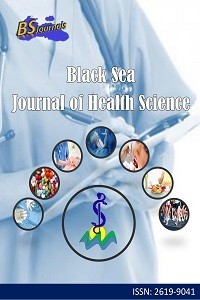The Impact of Temperature on the Synthesis of Silver Nanoparticles by Candida macedoniensis
Candida macedoniensis, Silver nanoparticles, UV spectrum, SEM, X-ray spectrum
The Impact of Temperature on the Synthesis of Silver Nanoparticles by Candida macedoniensis
Candida macedoniensis, Silver nanoparticles, UV spectrum, SEM, X-ray spectrum,
___
- Abo–State MAM, Partila AM. 2015. Microbial production of silver nanoparticles by Pseudomonas aeruginosa. Cell free extract. J Eco Heal Env, 3(3): 91–98.
- Anal KJha, Prasad K, Kulkarni AR. 2008. Yeast mediated synthesis of silver nanoparticles. Inter J Nanosci Nanotech, 4(1): 17-21.
- Bhainsa KC, D'Souza SF. 2006. Biomimetic synthesis of nanoparticles. Colloids Surf B, 47: 160–164.
- Bharde A, Rautaray D, Bansal V, Ahmad A, Sarkar I, Mohammad Yusuf S, Sanyal M, Sastry M. 2006, Extracellular biosynthesis of magnetite using fungi. Small, 2(1): 135-141.
- Egorova EM, Revina AA. 2000. Synthesis of metallic nanoparticles in reverse micelles in the presence of quercetin. Colloids and Surfaces A: Physicochem Engin Aspects, 168: 87-96.
- Ganbarov KhG, Jafarov MM, Hajiyeva FT, Bozkurt HC, Ramazanov MA, Eyvazova GI, Aghamaliyev ZA, Ahmedov IS, Abdulhamidova SM. 2015a. The study of the ability of Candida macedoniensis BSU-MI44 to synthesize silver nanoparticles. J Qafqaz Univ Chem Biol, 2015: 139–142.
- Ganbarov KhG, Jafarov MM, Hajiyeva FT and Bozkurt HC. 2015b. Studying of capacity of strains of yeast fungus Candida macedoniensis BDU-Mİ44 to synthesize nanoparticles of silver. Modern Mycology in Russia. In Proceeding of Materials of III International Mycological Forum, Moscow, Russia, 4: 82.
- Ganbarov KhG, Jafarov MM, Hajiyeva FT, Bozkurt HC, Ramazanov MA, Eyvazova GI. 2016a. The formation of silver nanoparticles by Candida macedoniensis BSU-MI44 depending on the amount of biomass. In Proceeding of International Scientific-Practical Conference On Actual Problems Of Modern Chemistry And Biology, May 12, Ganja, Azerbaijan, 2016:161–165.
- Ganbarov KhG, Jafarov MM, Hajiyeva FT, Bozkurt HC, Ramazanov MA, Eyvazova QI, Aghamaliyev ZA, Akhmedov IS. 2016b. Mycogenic Formation of Silver Nanoparticles by the Azerbaijanese environmental isolate Candida macedoniensis BDU–Mİ44. Inter J Res Stud in Biosci, 5: 1–5.
- Ganbarov KhG, Musayev EM. 2012. Microorganisms forming nanoparticles. Transaction of the Institute of Microbiol Azerbaijan National Acad, 10: 78–84.
- Kowshik M, Ashtaputre SH, Kharazi SH, Vogel W, Urban J, Kulkarni SK, Paknikar KM. 2003. Extracellular synthesis of silver nanoparticles by a silver- tolerant yeast strain MKY3 Nanotechnol, 14(1): 95 – 100.
- Li X, Xu H, Chen ZS, Chen G. 2011. Biosynthesis of nanoparticles by microorganisms and their applications. J Nanomaterial, 11(8): 1–17.
- Muthupandian S, Amelash T, Negash L, Gebreyesus A, Selvaraj A, Rayar V and Dheekonda K. 2013. Extracellular biosynthesis and biomedical application of silver nanoparticles synthesized from baker’s yeast. Inter J Res Pharma Biomed Sci, 4(3):822 – 828.
- Narayanan KB and Sakthivel N. 2010. Biological synthesis of metal nanoparticles by microbes. Advances in Colloid Interface Sci, 156 ( 1,2): 1–13.
- Sadowski Z, Maliszewska IH, Grochowalska B, Polowczyk I, and Koźlecki T. 2008. Synthesis of silver nanoparticles using microorganisms. Materials Sci, 26: 2419–2424.
- Sadowski Z. 2010. Biosynthesis and application of silver and gold nanoparticles. Wroclaw Univ Technol, 11: 257–276.
- Sastry M, Ahmad A, Khan MI, Kumar R. 2003. Biosynthesis of metal nanoparticles using fungi and actinomycete. Current Sci, 85: 162–170.
- Yayın Aralığı: Yılda 4 Sayı
- Başlangıç: 2018
- Yayıncı: Cem TIRINK
Banu TERZİ, Şehrinaz POLAT, İnci KAVLU, Hamdiye Banu KATRAN, Nurten KAYA
A Scientometric Analysis on Cardiac Echinococcosis
Cemile UYAR, Emine Kübra DİNDAR DEMİRAY, Serpil OĞUZ MIZRAKÇI, Mustafa Serhat ŞAHİNOĞLU
Mustafa Serhat ŞAHİNOĞLU, Sevil ALKAN
Zeynep KÜÇÜKAKÇALI, Fatma Hilal YAĞIN, İpek BALIKÇI ÇİÇEK
Pandemi Sürecinde Ebeveynlerin Koronavirüs Anksiyete Düzeyinin Ebeveyn Çocuk İlişkisine Etkisi
Sena GAYRETLİ, Duygu SÖNMEZ DÜZKAYA
Hamide ŞİŞMAN, Refiye ÖZGEN, Dudu ALPTEKİN, Sevban ARSLAN
A Bibliometric Overview on Endovenous Laser Ablation Research
Bazı Popüler Diyetlerin İmmünite Üzerine Etkileri
Emre ADIGÜZEL, Şeyma Nur KILIÇ, Almina YILMAZ, Gizem YURDAKUL, Ülkü Didar BİLEN, Ahsen TENİL, İrem YILMAZ
Cengiz TAŞKAYA, Buket BÜYÜKTURAN, Fatma KESKİNKILIÇ, Halil ALKAN, Öznur BÜYÜKTURAN
